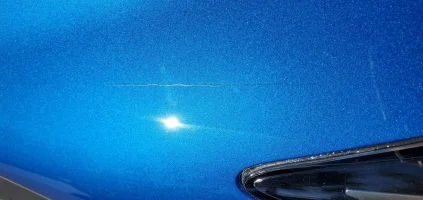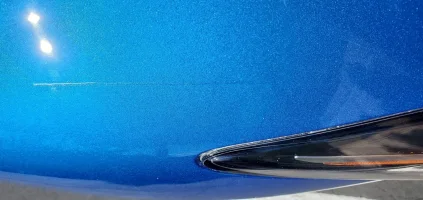stoopid
1000 Posts Club!
As some have read, I had an incident last week leaving a scratch in my fender. Details can be found here: Why we can't have nice things
The scratch is more like a knife cut, very thin and deep. Maybe 7" long. I can barely feel the scratch under my finger nail, but it's definitely through most if not all of the clear coat. It's also fairly dark inside the scratch, I did several runs of cleaning with a microfiber and even a soft toothbrush using 70% isopropyl.
After drying I applied my touchup pen, then polished using my harbor freight buffer and some polishing compound I already have. It worked so well it removed all the touchup paint (this was after 36 hours of drying and only light pressure).
So I cleaned the scratch again, applied another coat of the touchup paint and will be waiting 3 full days before my next attempt. I don't want to keep messing with and reducing the depth of the clearcoat so I'd like to get the repair with this next pass.
Now my question: what's the best strategy to blend this? I really don't care about color correctness obviously, it's not happening without paying a shop. I'd just like to get the surface blended so it's not obvious when looking at it in sunlight. I've never done it, but I'm wondering if careful wet sanding might be on order?
Pics of the touchup paint filled crack attached. The touchup repair looks better in person than the photos would indicate, I took the absolute worse angles I could find for purposes of showing the issue.


The scratch is more like a knife cut, very thin and deep. Maybe 7" long. I can barely feel the scratch under my finger nail, but it's definitely through most if not all of the clear coat. It's also fairly dark inside the scratch, I did several runs of cleaning with a microfiber and even a soft toothbrush using 70% isopropyl.
After drying I applied my touchup pen, then polished using my harbor freight buffer and some polishing compound I already have. It worked so well it removed all the touchup paint (this was after 36 hours of drying and only light pressure).
So I cleaned the scratch again, applied another coat of the touchup paint and will be waiting 3 full days before my next attempt. I don't want to keep messing with and reducing the depth of the clearcoat so I'd like to get the repair with this next pass.
Now my question: what's the best strategy to blend this? I really don't care about color correctness obviously, it's not happening without paying a shop. I'd just like to get the surface blended so it's not obvious when looking at it in sunlight. I've never done it, but I'm wondering if careful wet sanding might be on order?
Pics of the touchup paint filled crack attached. The touchup repair looks better in person than the photos would indicate, I took the absolute worse angles I could find for purposes of showing the issue.





